GENESIS
Sara Eliza Johnson
And where are the flowers?
The girls have plucked them.
And where are the girls?
They've all taken husbands.
And where are the Cossacks?
They all have gone to war.—traditional Ukrainian folksong, later adopted by Pete Seeger [1]
*
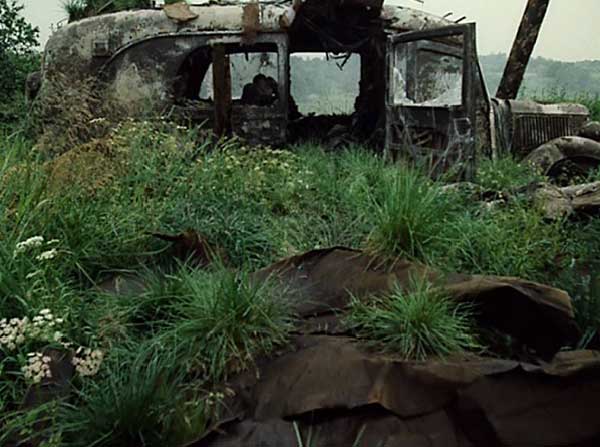
In the Red Forest the radioactive trees bow burned and deformed under the moon. Wolves shadowstalk a wild boar while the wild horses graze wisps of grass and the roe deer teases a mushroom from a root. The wind seems to be glowing. But no—it is only the moonlight, which rides the back of the owl like the voice of a ghost. Once, the plants of the forest glowed with an alien dust. Once the forest in the dead zone overflowed with green leaves, which writhed in the air like fish, and then it was red, and then only brown—a reddish brown, like bile dried on a shirt, like old blood stain on stone, or blood dried on the fur around the mouth of an animal. Some patches turned black and scabbed. Still, outside the dead zone much of the surviving forest remains green. Or: a dream of green. In the winter, snow falls heavily on the land, half-erasing the forest, erasing the footprints of the woman who walks and unearths mushrooms for the roe deer—because it is hard for them to find food under the snow—and the hedgehog and the moose. [2] Some travelers who come to visit this place have named themselves Stalkers. Some stalkers hunt the animals, and others for relics to sell. The trees in the Red Forest grow in all directions because they do not know which way the sky is. The albino swallows that wake and sing their bright particulate notes through the forest do not know what they signify.
*
In the house the stove's on, the lard is frying. You put a dosimeter to it, and you find it's not a stove, it's a little nuclear reactor.
I saw a man who watched his house get buried. We buried houses, wells, trees. We buried the earth. We'd cut things down, roll them up into big plastic sheets. We buried the forest. We sawed the trees into 1.5m pieces and packed them in Cellophane and threw them into graves.
—Arkady Filin, Liquidator [3]
*
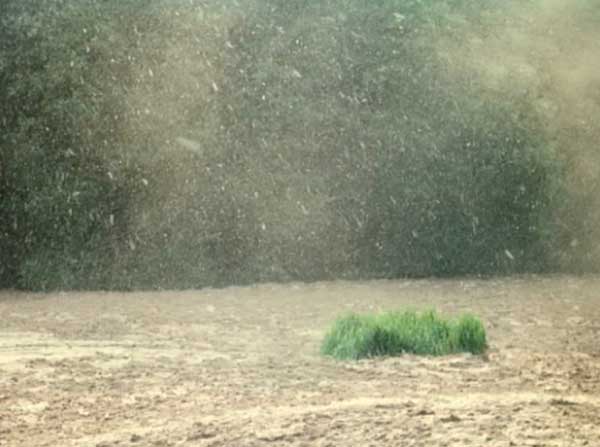
There was light. Uranium bloomed from the reactor, scattering silver-white specks over the land: a nuclear pollen. At the sight of the explosion, the radiation levels reached over twenty thousand roentgens per hour, and in the Zone of Alienation the trees (most of them Scots pines, or Pinus sylvestris) absorbed eight thousand roentgens an hour for days afterward. The radiation annihilated chloroplasts—the plastid in the plant cell that houses the chlorophyll—turning the trees to reddish rust, "burning" them where they stood. First, the buds died, and then the cellular tissue, and then the needles. Men buried the dead trees in long trenches. Many of the trees in the fallout zone that miraculously survived the initial explosion from Chernobyl died in the aftermath; the younger ones suffered more damage and abnormalities than the older ones, simply because they were growing at a faster rate, their cells were more vulnerable, and so the radiation they absorbed more profoundly altered their maturation. The radionuclides settled on each leaf-vein and feather-barb like a fine rain, nestled into water droplets and soil, emitting tiny bursts of gamma, alpha, and beta rays into the cells of each living thing, which is why many trees in the Red Forest still grow strange shapes, as if interplanetary, as if on another Earth.
*
We dug up the diseased top layer of soil, loaded it into cars and took it to waste burial sites. I thought that a waste burial site was a complex, engineered construction, but it turned out to be an ordinary pit. We picked up the earth and rolled it, like big rugs. We'd pick up the whole green mass of it, with grass, flowers, roots.
—Ivan Nikolaevich Zhykhov, Chemical engineer
*
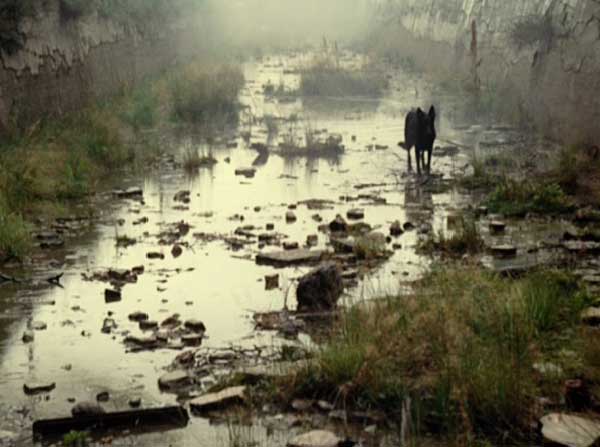
In Ukrainian demonology, one lisovyk rules each forest. All the animals follow him wherever he goes. At times the lisovyk is a horned beast and other times a wolf and other times a simple tree growing in the middle of a path, forcing the woods-walker to turn around, go back home. Even when he appears in human form, the lisovyk has no shadow. Traveler, should you venture alone into the forest, remember that sometimes the lisovyk stalks woods-walkers, and might send you walking in a circle, so that you return to the same coordinates again and again: a loop outside of time.
*
They announced over the radio that you couldn't take your belongings! All right, I won't take all my belongings, I'll take just one belonging. I need to take my door off the apartment and take it with me. I can't leave the door. It's our talisman, it's a family relic. My father lay on this door. I don't know whose tradition this is, but my mother told me that the deceased must be placed to lie on the door of his home.
—Nikolai Fomich Kalugin, Father
*
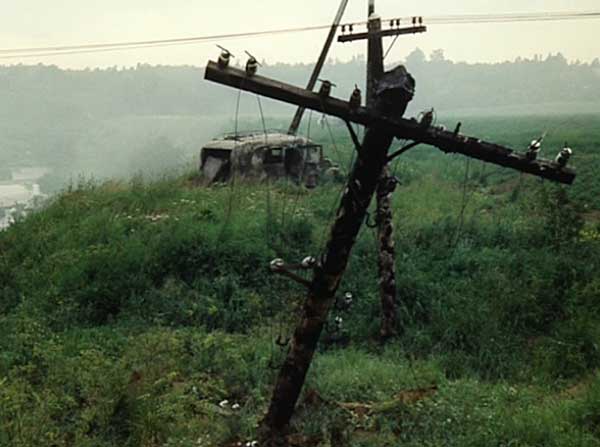
In the old stories, Baba Jaha the Bone Mother lives deep in the forest in a hut that stands on chicken legs. The hut, which can walk through the woods like a spider, which can spin and scream and moan through the fog, is decorated with human skulls, and protected by a fence of interlocked human skeletons. The witch Baba Jaha is emaciated and deformed. Because all her natural teeth have fallen out, she has iron teeth, which she uses to eat human children, and her nose is so long that when she lies down on her oven to sleep its tip touches the ceiling. Three bodiless hands appear around her to do her bidding, crown her with bones, servants severed from mysteriously absent bodies. Three horsemen also serve her: the White Horseman, the Red Horseman, and the Black Horseman (but not the Pale Horseman, who must serve another). Though Baba Jaha is a monster, she does not always play the villain in these stories. But she is always alone in the forest, and very hungry.
*
I took it with me, that door - at night, on a motorcycle, through the woods. It was two years later, when our apartment had already been looted and emptied. The police were chasing me. "We'll shoot! We'll shoot!" They thought I was a thief. That's how I stole the door from my own home.
—Nikolai Fomich Kalugin, Father
*
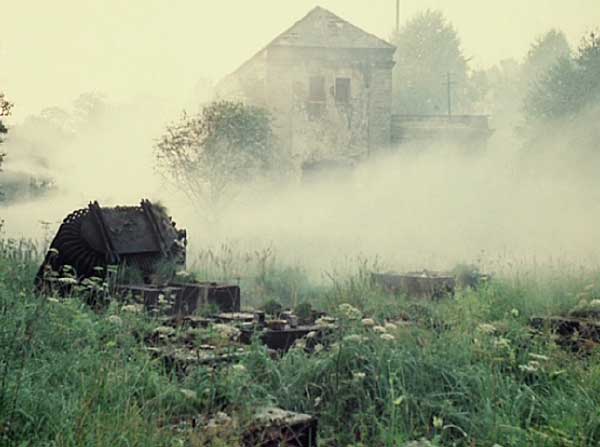
Of all the living things in the Exclusion Zone, the mushrooms growing on the floor of the Red Forest soak up the most radionuclides, since their mycelium can spread nearly fifty feet through the soil. Like little brains, they thrive in the radioactivity, and should not be hunted and eaten. Consider that inside and around the ruins of the plant grows a radiotrophic fungus, a black mold that uses pigment melanin to convert the gamma radiation into chemical energy. Consider that this is how they grow, these living scabs, these dark forms that startle and writhe under the researcher's microscope: by harnessing particles of gamma decay, as algae blooms harness photons from the sun. In one story, a Ukrainian scientist and his Italian companion find themselves stranded on an empty highway right outside the Exclusion Zone. Their car has broken down, and it is very cold; they need somewhere to spend the night. Like characters at the beginning of a horror film—the strangers destined to die before the heroes arrive—the men abandon their car and walk the road near the ruins alone in the dark. After much time has passed, they reach a village, where a woman invites them inside her home. The woman's house is but one room and a kitchen. Only the living room has a fireplace, and the woman offers to sleep in the freezing kitchen, so that the two scientists can use her bed. For breakfast the next morning she makes them a soup from mushrooms she had picked herself in the woods surrounding the village. I'm not going to eat this! the scientist's companion whispers to him. This is all she has, the scientist replies. No, no, the other man says. So the scientist tells the woman that his companion has a stomachache, and eats the radioactive soup. [4]
*
We had good jokes. Here's one: an American robot is on the roof for five minutes, and then it breaks down. The Japanese robot is on the roof for five minutes, and then breaks down.
The Russian robot is up there two hours! Then a command comes in over the loudspeaker: "Private Ivanov! In two hours, you're welcome to come down and have a cigarette break."
Ha-ha!
—Aleksandr Kudryagin, Liquidator
*
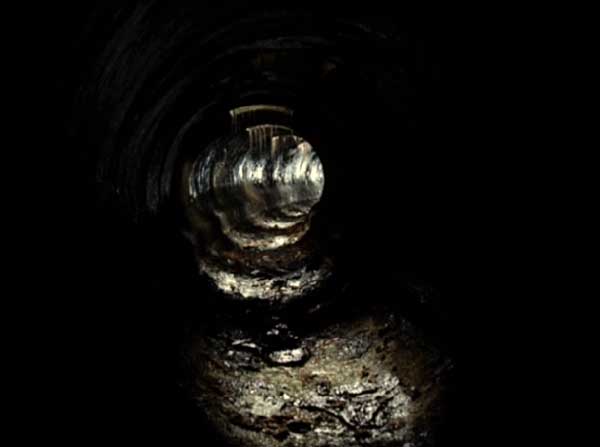
After the explosion, the Liquidators rushed to the site, wearing nothing but their own makeshift armors of lead aprons, gas masks, and hospital masks. As the firefighting team fought the flames on the roof, a diving team consisting of two chemical engineers and one lamp-bringer dove into the pool of water beneath the reactor to open the gate that would drain it, as the reactor floor was becoming very hot with corium lava. The molten material—a bright flow of reactor uranium dioxide fuel, zircaloy cladding, concrete, and decomposed serpentite—threatened to burn through the floor into the pool, which would have caused a steam explosion even more catastrophic than the previous two explosions. So critical was this mission that, when the lamp broke, the two engineers felt their way to the valves through the radioactive darkness, like prehistoric blind fish through a deep sea trench. Afterward the Liquidators buried the dead trees and flowers in the Red Forest, constructed shelters for the evacuees of Pripyat, and built the Sarcophagus around the reactor, where, amid cooled lava flows and stalactites, it lies sepulchered still: a beast contained, though not quite dead. Many of these Liquidators, including the three divers, soon died from acute radiation sickness or radiation burns. Their hair fell out, and their bodies blistered and ulcerated, as if islands in a sea of lava—islands in the age when Earth was fire—while inside them their organs flowered black and red. Fireman Nikolai Ivanovych Titenok died in the hospital with a blistered heart. They buried him—along with all the others—in a lead coffin.
*
One night I heard a noise. I looked out the window. He saw me. "Close the window and go back to sleep. There's a fire at the reactor. I'll be back soon."
I didn't see the explosion itself. Just the flames. Everything was radiant. The whole sky. A tall flame. And smoke. The heat was awful. And he still hadn't come back.
—Lyudmilla Ignatenko, Wife of fireman Vasily Ignatenko
*
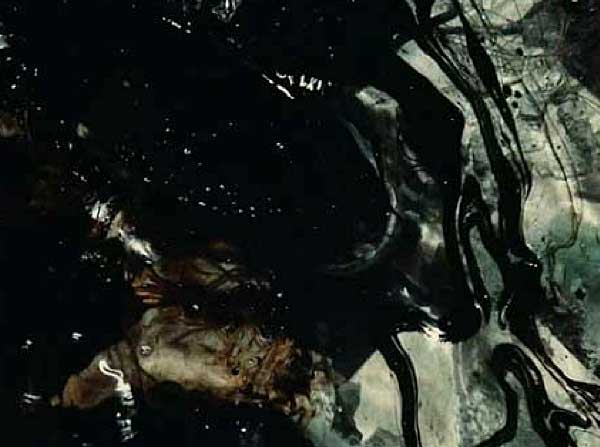
Deep in the forest at night, near a small lake or pond, the wanderer might come across a beautiful young woman, her skin naked and translucent, her eyes pupil-less, her hair long and flowing in the windless moonlight. This is the rusalka, a water-demon. According to the demonology, though the rusalka lives in the lakes and rivers—though she cannot let her hair dry completely, or else she will die—on some nights she will rise from the water to climb a tree and sing to the Moon. Because they are the souls of unclean dead, contaminated dead, unbaptized dead, the dead who have not had their last rites—dead who have died suddenly, or violently—the rusalki will never rest. Their skin glows with an eternal fury. They are insatiable. Their song feels honed for your ear to hold, as a smooth, wet stone seems made to fit your palm. When wandering at night you must keep your distance from the rusalki. If you stop to hear them, they will sing you down into the water, where, still listening to their glimmering moans, you will drown.
*
I took my daughter and my wife to the hospital. They had black spots all over their bodies. These spots would appear, then disappear. They were about the size of a five-kopek coin. But nothing hurt. They did some tests on them. My daughter was six-years-old. I'm putting her to bed, and she whispers in my ear: "Daddy, I want to live, I'm still little." And I had thought she didn't understand anything.
—Nikolai Fomich Kalugin, Father
*
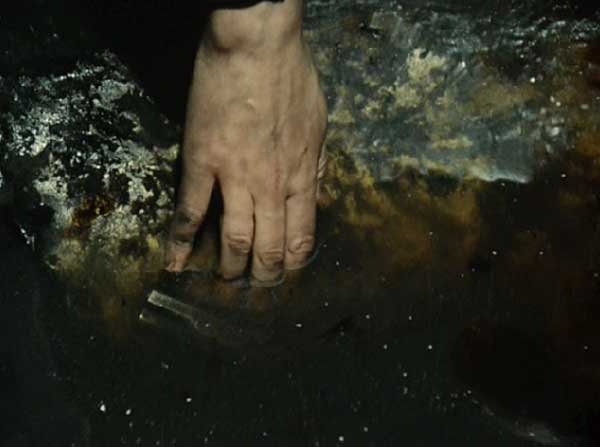
Seven years before the nuclear meltdown at Chernobyl, the beloved Andrei Tarkovsky made Stalker, an epic film in which three nameless men—a Writer, Professor, and the Stalker who guides them—explore an uninhabitable and hostile area of wild land called The Zone. The Zone exists outside of a crumbling city, a ruin of skeletal clouds. Like the three pilgrims in the Pardoner's Tale, who set out on a quest to kill Death, or perhaps the three Magi who travel to see the infant Christ, the men wander through the apocalyptic fog and silence of a haunted realm in search of a place called The Room: a magical place, a locus point of energy, where one's deepest wish comes true, bears fruit. According to the legend, twenty years ago something rained from the sky, some very powerful object or force—one so powerful that what fell burnt down a village and all the land around it. The people thought at first that the object had been a meteorite, but they found no evidence of one. Many who entered The Zone simply vanished, while others returned to the human world mutilated or mutant. So the military erected a barbed-wire fence to keep the curious people out, and that's when people started talking about The Room. Some who evaded the guards and braved the wastes to find The Room died at its doorstep; some never made it farther than halfway there. Like a labyrinthine body alive and breathing, like the intestines of some grand beast, The Zone the men traverse shifts and changes itself before their eyes, misdirects them, sets traps for them—such as a wind-pocket that could crush a human body—that the Stalker locates through his handmade detector: metal nuts tied together with strips of cloth. Sometimes The Zone speaks to the men in their own voices. It leaves a pile of still-brightly-burning coal in the water of a stream they cross. Among other sinister miracles, flowers bloom in the wasteland, but have no scent. The Zone tries to kill every human who enters it, the Stalker says, so no humans live in it. They are alone in these wilds, he assures the two men, and yet as he leads them through ruined buildings, past an abandoned power plant, a decomposing corpse in a rotted-out bus, across overgrown fields scarred with abandoned artillery, in the distance someone is wailing.
*
When the girls in my class found out that I had cancer of the blood, they were afraid to sit next to me. They didn't want to touch me.
The doctors said that I got sick because my father worked at Chernobyl. And after that I was born. I love my father.
—Vanya Kovarov, 12
*
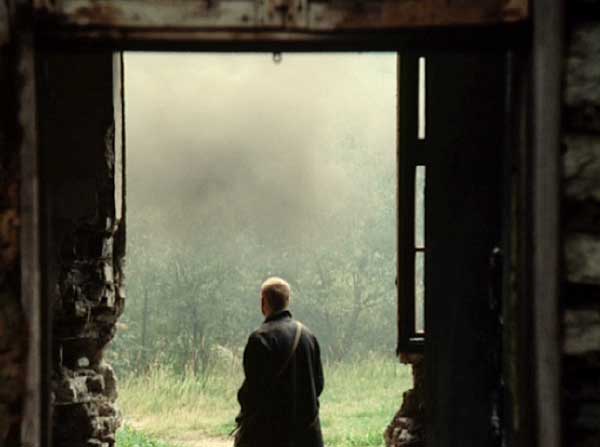
Twenty-one years after Chernobyl's nuclear meltdown, Ukrainan video-game developer GSC Game World released S.T.A.L.K.E.R: Shadow of Chernobyl, a first-person shooter in which the player character wanders The Zone (of Alienation) in an alternate reality where the area suffered another explosion. In the story, Ukraine had already begun slowly but determinedly repopulating The Zone with scientists and military personnel when the O-Consciousness program (which in Ukrainian means realization or awareness) triggered another meltdown. The Zone in this alternate Earth is a necropolis roamed by ravenous, mutant creatures that eat only non-irradiated flesh, is a minefield of physical "anomalies" or distortions that swallow and kill trespassers through crushing pressure or electric shocks. Still, many scavengers brave the radioactive wasteland of The Zone to poach the scientific artifacts these anomalies produce, which are rare and expensive. One year after the second explosion, the player character—a Stalker named The Marked One by the man who finds him—wakes up in a shelter with amnesia, with no evidence of his old life except a tattoo of the acronym S.T.A.L.K.E.R. (meaning: Scavengers, Trespassers, Adventurers, Loners, Killers, Explorers, and Robbers) on his arm, and a PDA with a note written to himself: Kill Strelok. In his quest to kill Strelok the Marked One must disable the Brain Scorcher, a military signal that not only destroys the minds of living things that enter it, but reprograms them into violent undead. He must descend into the depths of the destroyed power plant to find the Wish Granter, an extraterrestrial device that rewards The One who survives the trials required to reach it. In a narrative twist, The Marked One discovers that he is Strelok, who, in his amnesia, in the wake of his trauma, had somehow forgotten his own life. Come to me, the device says to the player. You will gain what you deserve. Your wish will soon come true. Come to me. Your path is ending.
*
On the meadow where we picked all the yellow flowers in the spring, we had to transplant grass several times, because there was low lying ground there, and the grass froze at night and turned yellow from the frost. We continued shooting the following year, when new grass had grown, and suddenly blue flowers appeared, and we had to pick them all, too.
—Marianna Chugunova, Tarkovsky's Assistant on Stalker
*
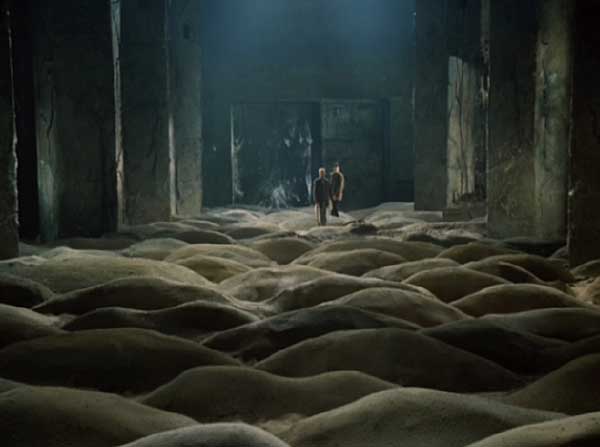
Because a massive earthquake decimated the land surrounding the derelict Chinese mine in Tajikistan that had originally captivated the film crew, and because the pollution levels in the area near the foundry in Ukraine—an open pit of rainbowed rocks and glittering clouds of smoke—deemed it too hazardous for filming, for The Zone Tarkovsky settled on his third choice: a forested area of land that stretches between two abandoned hydroelectric power plants on the Jägala River in Estonia. If you ever find yourself walking there, and wander inside one of the power stations—destroyed by the Red Army in 1941—you will still find a tiny sea of sand dunes rippling across the floor, a passage the three men in Stalker cross on their quest to The Room. The film's dream archaeology (as critic James Norton so aptly phrases it [5]) was meticulously and obsessively cultivated over the filming period; all scenes required six or seven takes, and the entire film had to be shot a second time because the first footage had been ruined. The crew worked tirelessly to maintain the architecture of the dream, as one member recalls: We had to pull down all the yellow leaves in the forest so that the new takes had the same colors as the material shot previously. They waited for the frost to melt in the morning, because everything was bluish and sparkling in the sun. The maples were first yellow, then pink, then red and finally purple. We had to pull down all those leaves and leave the green ones only. We thinned the forest. But the forest still came back, grew new limbs and flowers that, despite the chemicals in the air, smelled of Spring. It is said that this spot is where Tarkovsky inhaled the seed that bloomed the cancer that would eventually kill him. The sound designer for the film remembers: Up the river was a chemical plant and it poured out poisonous liquids downstream. There is even this shot in Stalker: snow falling in the summer and white foam floating down the river.
*
I couldn't sleep at night. I'd close my eyes and see something black moving, turning over—as if it were alive—live tracts of land, with insects, spiders, worms. I didn't know any of them, their names, just insects, spiders, ants. And they were small and big, yellow and black, all different colours.
One of the poets says somewhere that animals are a different people. I killed them by the ten, by the hundred, thousand, not even knowing what they were called. I destroyed their houses, their secrets. And buried them. Buried them.
—Arkady Filin, Liquidator
*
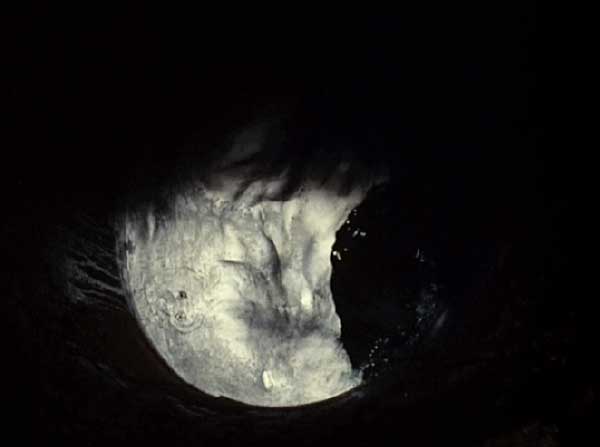
Enclosed deep inside the sarcophagus, deep inside the mold-scabbed reactor room of the Chernobyl power plant, nestled inside the long-cooled glass-flow of corium lava named The Elephant's Foot, lies a unique technogenic mineral called chernobylite. Chernobylite is, in the simplest geological terms, a silicate of zirconium with a high concentration of solid uranium. Bright yellow and crystalline, as if bioluminescence at the bottom of an extraterrestrial ocean, today the mineral is still alive with radioactivity, still crackles like a brain, or a portion of one, as it sends unanswerable signals out into the world. The chernobylite born of corium-lava is an anomaly—conceived of Earth, like other minerals from the lava-core, and yet monstrous and alien to the planet, as if it should not be here, does not belong—and certainly, if the chernobylite were no longer radioactive, if a human being could hold a single crystal for longer than three-hundred seconds and survive, it would fetch a good price, for it exists nowhere else in the world but in The Zone. But the chernobylite and radiotrophic fungi are not the only rare creatures to flourish there. The Red Forest has also become home to the endangered Przewalski's Horse, which is the last remaining species of wild horse on the planet. Despite the residual radiation, and despite the many trespassers who come to poach them for their meat, the animals have bred beautifully here, in this place without humans, this Other Earth born of annihilation. They leave runes in the snow with their hooves; their breathing in the cold constructs crystalline clouds in the air, ghost stones you could almost hold, if only they would let you come closer.
*
About Chernobyl, the different theories. Some say that aliens knew about the catastrophe and helped us out. Others that it was an experiment, and soon kids with incredible talents will start to be born. Or maybe the Belarussians will disappear, like the Scythians, Sarmats, Kimmeriys, Huasteks. We're metaphysicians. We don't live on this earth, but in our dreams, in our conversations. Because you need to add something to this ordinary life, in order to understand it. Even when you're near death.
—Viktor Latun, Photographer
*
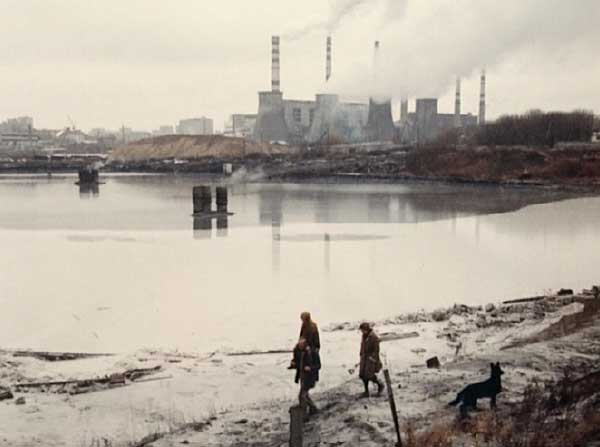
The original title for Stalker was The Wish Machine. In the first version of the script, the Stalker is searching for The Room because he seeks a cure for his young daughter's paraplegia. In the film, however, he tells his two followers that he seeks nothing for himself, and that, having lost the last remnants of his own faith and hope, he only wishes to help others recover their own. In the version of the story we see, each of the three men has a reason for wandering this forbidden land to find The Room. Each has risked his life for this fabled gift. Yet, when they reach the door, none of them enter. It seems they are afraid to die there, to be sucked into the crypt, to become anomaly, or to leave maimed or deformed—turned inside out, perhaps, or skinned alive—by a terrible wish they did not know they had harbored inside themselves. And so their fear of themselves, of their true insides, overcomes their wonder and curiosity, as well as their greed. Sometime during the quest, off-screen and in secret, the professor has picked up a bomb from a bunker, would like to destroy The Room, but the Stalker begs him to reconsider: The Room, he says, is the only place where one can come if there's no hope left. Suddenly it begins to rain inside the building. The men sit down and wait in silence for the rain to stop falling before journeying back to the city. A black dog follows them there, all the way back, and returns with them to the room where their journey began. The Stalker gives the dog something to eat. Where did the dog come from? his wife asks him. There it stuck to us, he says, as if it was pollen in the hair, or oil on a fingertip. We couldn't forsake it.
*
Once there were brook trout in the streams in the mountains. You could see them standing in the amber current where the white edges of their fins wimpled softly in the flow. They smelled of moss in your hand. Polished and muscular and torsional. On their backs were vermiculate patterns that were maps of the world in its becoming. Maps and mazes. Of a thing which could not be put back. Not be made right again. In the deep glens where they lived all things were older than man and they hummed of mystery.
—Cormac McCarthy, The Road
*
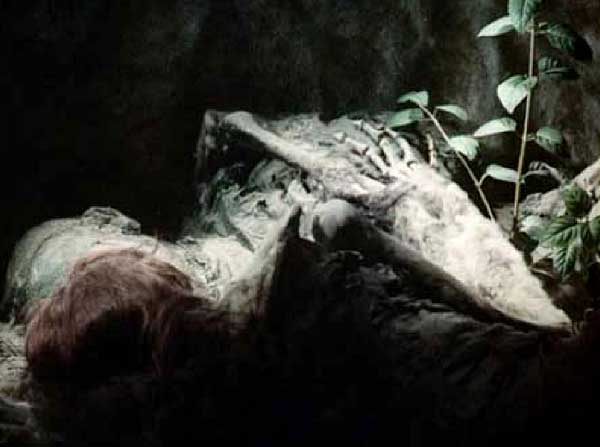
All across the land, in the sunlit leaves and in the dark grains of soil and underground in the roots and exploding webs of mycelium, the explosion still radiates its labyrinthine echo. In some pockets of the forest, the radioactive particles are especially alive, invisible and deadly clouds hovering in space, like portals into a forbidden universe. The burial of the radioactive trees and flowers—all the work done, and the men poisoned—has only elongated the life of the radioactivity in The Zone. The job was rushed, the items not hydro-isolated, meaning that groundwater can still reach them, and deposit radionuclides throughout the land. Thus, the area that surrounds Chernobyl's Reactor-4 will be uninhabitable for longer than first thought.
The feral forest that still breathes its strange wind around and through the leaves and animal fur and bird feathers, through the decomposing bones of Pripyat, is not quite prophesy, not quite dream, not quite nightmare. The forest is more like an inverse Eden, or perhaps a story telling itself to itself—a story that began with us, but that spirals farther and farther away from us across space and time. Such stories remain materially untouchable. They can only be excavated and reborn in the forests of our imaginations—the waste graveyards, zones of alienation—not as lies or delusions, but ordinary truths of our own horror mutated into sites of sublimity. Again and again we make maps to a maze that leads to the same void: a mirror.
And when all the mysteries have gone extinct, when we have annihilated all trace of them, surely we will invent replacements—things miraculous and pure and rare—and build tombs for them, and scramble the maps so that we cannot find them to ruin them, and forget them there. We will bury the mysteries deep in the ground and wait to see what life (or death) they grow.
And one day we will become the dream archaeology, the irrecoverable evidence of our disaster. Nothing will find us. Our bones will sink like primordial arrows into the earth, crawl lower and lower toward that red light, until they are swallowed by the magma churning at the planetary core, which is always moving, rotating.
And then, one day, the core will turn utterly dark and still: an inhuman stillness, from which what was buried rises not as the living dead, but as new forms of life that we cannot recognize. And yet how we would recognize ourselves in them, in these things remade from our material, though we could not survive them, though they would not let us near.
_____
Notes
[1] All images featured are film stills from Stalker (1979), directed by Andrei Tarkovsky and distributed by Mosfilm. Credit: Filmgrabber (http://film-grab.com).
[2] Valentina Sachepok, profiled in "Do Animals in Chernobyl's Fallout Zone Glow?" by Mary Mycio at Slate.
[3] All quotations of Chernobyl survivors are excerpted from Voices from Chernobyl: The Oral History of a Nuclear Holocaust (Picador 2006), curated by Svletana Alexievich and translated by Keith Hessen.
[4] Dr. Sergiy Zibtsev, as profiled in "Chernobyl expert takes a look at Tohoku's trees" by Winifred Bird in The Japan Times (Japantimes.co.jp).
[5] Norton uses the phrase in his essay "Stalking the Stalker" at Nostalghia.com
__
Though not a personal essay, it could have been. Ever since it was suggested to me that my grandmother—who lived in Warsaw in 1986—developed her fatal cancer due to Chernobyl's fallout, I have been fascinated by it.
![[TOC]](16_4_toc_t_off.jpg)